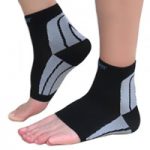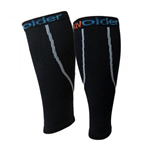Deep Vein Thrombosis, aka DVT, is a medical condition that occurs when a blood clot (thrombosis) or clots form in the deep veins of your legs. DVT typically causes swelling and pain, but you can also have DVT and not notice any symptoms. DVT is very serious. When a blood clot breaks free and travels through your bloodstream, it can lodge in your lungs and block your blood flow. This is called a pulmonary embolism and it makes a heart attack or stroke more likely. DVT can be treated with medications, medical and compression wear, and physical therapy.
An Overview of Deep Vein Thrombosis (DVT)
There are many veins in our arms and legs from superficial veins that are very close to the surface of our body to deep veins that are far from the surface. Unlike superficial veins which are not paired with an artery, deep veins are. Deep veins are almost always beside an artery with the same name such as the femoral vein and femoral artery. While blood clots in superficial veins rarely travel anywhere, blood clots in deep veins can break free and travel in the blood stream. Sometimes the body heals itself and the blood clot disappears on its own, but other times the blood clot can lodge in the lungs and block blood flow. This can lead to a pulmonary embolism from which you can die.
Signs and Symptoms of Deep Vein Thrombosis (DVT)
Signs and symptoms of Deep Vein Thombosis (DVT) may include:
- Swelling in the affected leg (rarely do both legs swell)
- Leg pain
- A reddish discoloration of the skin
- A heated feeling in the leg
It is important to note that you can have Deep Vein Thrombosis (DVT) and experience no symptoms of the condition.
Causes of Deep Vein Thrombosis (DVT)
There are many potential causes of blood clots in deep veins , including:
- An injury to the vein
- Surgery on the leg
- Certain medications
- Limited or restricted movement
Risk Factors
Factors that increase your risk of developing Deep Vein Thrombosis (DVT) include:
- Inheriting a blood-clotting disorder
- Genetic disposition and family history
- Injury or surgery
- Prolonged bed rest or paralysis
- Being overweight
- Pregnancy
- Certain medications such as birth control and hormone pills that increase blood clotting
- Diseases that cause inflammation such as Cancer and Crohn’s disease
- Sitting for long periods of time, especially driving and flying
- Being over 60 years of age
Treating Deep Vein Thrombosis (DVT)
The treatment options for Deep Vein Thrombosis (DVT) seek to keep the blood clot from getting bigger and preventing it from breaking free. This both treats an existing blood clot as well as decreases the likelihood of other blood clots forming. Deep Vein Thrombosis (DVT) treatment options include:
- Anticoagulant medications (blood thinners)
- Thrombolytic medications (blood clot busters)
- IVC filters (vein filters)
- Compression wear (stockings, socks, and sleeves)
- Compression pumps (for severe cases of DVT)
What You Should Do
As with any medical condition, you should regularly see your doctor and follow your doctor’s orders. This is especially important to do if you have Deep Vein Thrombosis (DVT). Things you should plan to do include the following:
- Regularly visit your doctor
- Take blood thinners as directed and usually for at least 6 months
- Pay attention to any bleeding that you may have as even a minor cut can refuse to coagulate and become a serious condition
- Get up often, move around, and do not be sedentary
- Wear compression products (socks and sleeves) to improve blood flow, reduce swelling, and prevent blood clotting
For More Information on Deep Vein Thrombosis (DVT)
National Library of Medicine – Deep Vein Thrombosis (DVT)
Mayo Foundation – Deep Vein Thrombosis (DVT)
WebMd – Deep Vein Thrombosis (DVT) Help Center
Uvoider Compression Foot Sleeves and Calf Sleeves (15-20 mmHg and 20-30 mmHg)
Uvoider UV Compression Foot Sleeves – More Support™ Series (20-30 mmHg

Uvoider UV Compression Calf Sleeves – More Support™ Series (15-20 mmHg and 20-30 mmHg


